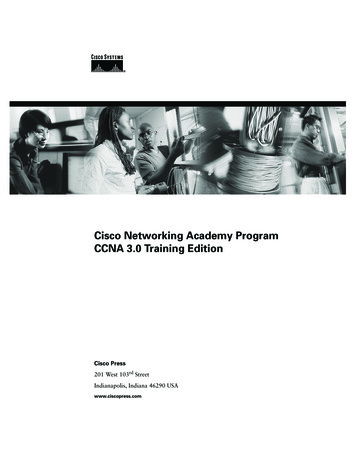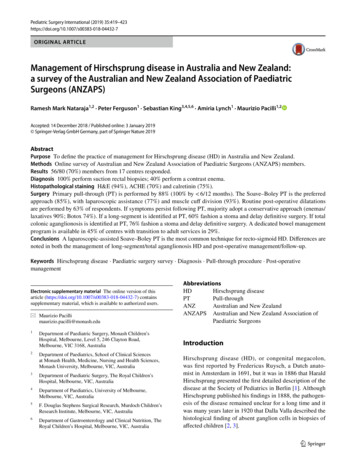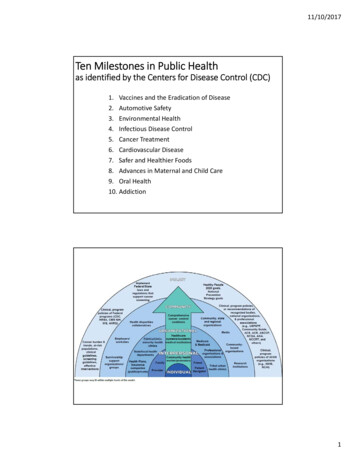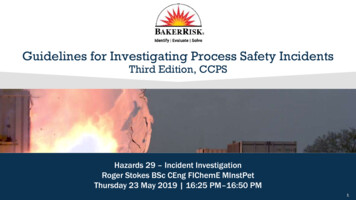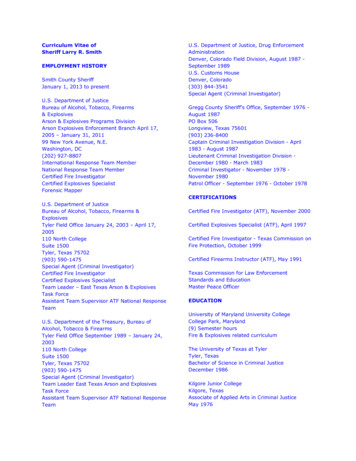
Transcription
Module 7: Outbreak Investigation & Disease Control – Outbreak InvestigationTRANSCRIPTSlide 1: tionDeveloped through the APTR Initiative to Enhance Prevention and PopulationDevelopedthroughthe APTR Initiativeto BrodyEnhancePreventionand PopulationHealthEducationin collaborationwith theSchoolof Medicineat EastHealth UniversityEducation incollaborationwithBrody forSchoolof Medicineat EastCarolinawithfunding fromthetheCentersDiseaseControl andCarolina University with funding from the Centers for Disease Control andPreventionPreventionHello, and welcome to Module 7: OutbreakInvestigation. My name is Krissy Simeonsson.I’m an assistant professor with the Departmentof Public Health and Pediatrics at the BrodySchool of Medicine.Slide 2: odule: PHDepartment of Public HealthDepartment of Public HealthBrody School of Medicine at East Carolina UniversityBrody School of Medicine at East Carolina University JulieJulieDaugherty,Daugherty,MPHMPHDepartment of Public HealthDepartment of Public HealthBrody School of Medicine at East Carolina UniversityBrody School of Medicine at East Carolina UniversityThis education module is made possible through the Centers for Disease Control and Prevention (CDC) and theThis educationmodule is Teachingmade possiblethrough theCentersfor DiseaseControl and(CDC) andAssociationfor Preventionand 60.The modulerepresentstheforopinionsof theauthor(s)anddoes not(APTR)necessarilyrepresentthe views ofCenters for Diseaserepresentsthe opinionstheauthor(s) anddoes not necessarilyrepresentthe views of the Centers for DiseaseControland PreventionoroftheAssociationfor PreventionTeaching andResearch.Control and Prevention or the Association for Prevention Teaching and Research.This education module is made possible througha cooperative agreement between the Centersfor Disease Control and Prevention and theAssociation for Prevention Teaching andResearch. APTR wishes to acknowledge thefollowing individuals that developed thismodule Slide 3: What do the following have incommon?What do the following have in common?Cantaloupes, peanut butter, frozen strawberries,ground beef, milk, and oysters?Page 1
Module 7: Outbreak Investigation & Disease Control – Outbreak InvestigationTRANSCRIPTSlide 4: Foodborne Outbreaks in the NewsAll of these foods have been implicated in foodborne outbreaks in the past 5 years in the UnitedStates. While this presentation is going to focuson the steps of an outbreak investigation, andmost investigations do center around infectiousdiseases, realize that not all outbreaks may havean infectious source.Slide 5: Presentation ObjectivesDuring the course of the presentation today weare going to start with defining some of the3.3.terms that we hear a lot with outbreaks.4.4.Principally we are going to look at the termoutbreak versus epidemic, and also define theterm pandemic. We are going to discuss reasonsthat outbreaks occur, then we’re going to spendsome time figuring out the rationale for investigating outbreaks. Why do we bother, whyis it important? Finally, we’re going to spend the majority of the presentation describingthe steps of an outbreak investigation. And what you’re role as future healthprofessionals might erstand the rationale for investigationSlide 6: Epidemic V. OutbreakWe often hear the terms, outbreak, andepidemic, used in the media, and it seems particularperiodperiodofoftimetimethey’re interchangeable, but actually there is a OUTBREAKOUTBREAK difference between these terms. An epidemicdiseasedisease CLUSTERCLUSTERrefers to an occurrence of more cases of a pectedexpecteddisease than expected in a given area or among aspecific group of people over a particular periodof time. In comparison an outbreak is an epidemic, but it’s limited to a localized increasein the incidence of disease. Another term that you might hear is, a cluster, and this is notan epidemic nor is it an outbreak. A cluster is just merely a group of cases in a given areaover a particular period without regard to whether the number of cases is more thanexpected. EPIDEMICEPIDEMIC asediseasethanthanexpectedexpectedininaaPage 2
Module 7: Outbreak Investigation & Disease Control – Outbreak InvestigationTRANSCRIPTSlide 7: What is a Pandemic?So we’ve defined the terms for epidemic andoutbreak, but not what a pandemic is. Apandemic is an epidemic occurring over a InfluenzaInfluenza mesyndrome(SARS)(SARS)widespread area and usually affecting a TuberculosisTuberculosis ndromesyndrome(AIDS)(AIDS)substantial proportion of the population. Oftenwith high levels of morbidity and also sometimeshigher levels of mortality. I’ve listed here someexamples of infectious diseases that have caused pandemics, most notably Influenza isvery well known for causing pandemics. Also Severe Acute Respiratory Syndrome (SARS),tuberculosis, and also HIV/ AIDS. oportionofofthethepopulationpopulationSlide 8: Mortality RateThis graph shows the mortality rate due toinfectious diseases in the United States over the20th century. On the y-axis is the number ofdeaths per 100,000 population, and on the x-axisis the 20th century in 20 year intervals. And youcan see overall in the 20th century there was asteady decline of mortality, the mortality rate,due to infectious disease. But there is one large, ominous, spike centered around 1918,and this is where the mortality rate almost doubled. This was due to the Spanish flupandemic of 1918. This is a graphic example of what a pandemic can do to about/graph.htmAGENTAGENT Increase Increaseininamountamountororvirulencevirulence Introduction shasnotnotbeenbeenbeforebeforeSlide 9: Epidemiologic TriadWe are now going to turn to the reasons thatepidemics occur. This diagram depicts theepidemiologic triad, which is made up of theagent, the host, and the environment. An agentENVIRONMENTHOSTENVIRONMENTHOSTcan be transmitted to a host to cause infection Change Conducive Changeininsusceptibilitysusceptibility Conducivetotointeractioninteraction Factorsthatincreaseexposurebetweenhostandagent Factors that increase exposurebetween host and agentby a variety of ways. There can be airbornetransmission. There can be direct contact as aroute of transmission. There can be spread through foods, insects can spread diseases,so there are a lot of different modes of transmission. Enhanced EnhancedmodemodeofoftransmissiontransmissionSo, how do epidemics or outbreaks occur? You can start with a change in the agentPage 3
Module 7: Outbreak Investigation & Disease Control – Outbreak InvestigationTRANSCRIPTitself. There can be an increase in the amount of agent, or the virulence of the agent.You can also have introduction of the agent into a setting where it has not been before.So, those are two factors related to the agent as part of this triad. Looking down at thehost, certainly, the host can have a change in susceptibility, so they can become lessimmune, or may have risk factors that make them more susceptible to an infectiousdisease. You can also have host factors that increase their possibility of being exposed.Maybe some occupational hazard they have, some other type of recreational activity,certainly, can increase their exposure.Finally, the environment can be conducive to the interaction between the host and theagent so you can have an environment that brings those two other components of thetriad closer together. Finally, there can be an enhanced mode of transmission, so theagent can be transmitted to the host in a way that’s more efficient at causing infection.Slide 10: Why Investigate OutbreaksNow we are briefly going to talk about why weinvestigate outbreaks, and what is the rationale PublicPublicconcernconcern PoliticalPoliticalinterestinterestfor doing that. This list was adapted from a self ProgramProgramconsiderationsconsiderations TrainingTrainingstudy case available at the Centers for DiseaseControl and Prevention website, and it’s part of acase, Principles of Epidemiology and PublicHealth Practice, 3rd edition. The most importantreason that we investigate outbreaks is to prevent and control the further spread ofdisease. So, obviously that is first on everyone’s mind when we talk about investigatingan outbreak. There may also be a role for research in doing an outbreak investigation.We may want to conduct research into a new laboratory method to diagnose diseases,there may be need to do research to look at why certain people are more susceptible,what risk factors do they have. Sometimes outbreaks even though they may not be scaryto health professionals, may really concern the public. So, often there is pressure fromthat side. Oftentimes there can be political pressure in investigating outbreaks.Certainly, program considerations are a reason. If there’s a program already in place tocontrol a certain disease and an outbreak occurs, it’s important to investigate anoutbreak to see if something isn’t working the way it should be. PreventionPreventionandandcontrolcontrol p://www2a.cdc.gov/TCEOnline/Finally, outbreaks provide a great opportunity to train other epidemiologists, as well ashealthcare professionals who are interested in public health.Page 4
Module 7: Outbreak Investigation & Disease Control – Outbreak InvestigationTRANSCRIPTSlide 11: Steps of an Outbreak InvestigationSo I’ve listed here the 10 steps of an outbreakinvestigation, and depending on what referenceor resource you use the list may look a little bitdifferent from one source to the next. But really,if you look closely at any list that describes thesteps of an outbreak investigation you’ll findpretty similar steps. Sometimes they’recombined or expanded further, but for the sake of simplicity we’ve listed ten of themhere. It’s important to realize that these are listed in sort of a conceptual order, but inreality during an outbreak investigation several steps may be happening at the sametime, or in a different order, most notably step number nine (control measures).Oftentimes at the beginning, of an outbreak investigation, you may have some idea ofwhat the cause is. If you have an idea about the source or the way the disease is beingtransmitted you may want to go ahead and put some control measures in place evenbefore you’ve tested your hypothesis or performed additional studies. We are going togo through these in a step-wise approach, but in real life, in an outbreak investigationthese may be happening in less of an order, so to speak. I did want to mention before Iget into the steps what your role as future healthcare professionals would in this.Certainly, you may be the front line person for step number one who determines thatthere might be an outbreak. You might recognize several cases occurring in yourpractice, and report those to the health department. You may be involved in helping toverify the diagnosis. Oftentimes the health department will ask for certain lab studies, soyou may help in obtaining that for them. Step number four in identifying additionalcases, oftentimes health departments will ask healthcare providers to help them findmore cases when an outbreak is on-going. Depending on your level of interest inworking with public health, you may help with epidemiologic studies. Step number nineis everyone’s job, so certainly, implementing control measures, helping to recommendcertain control measures is something you may be involved with. Finally, communicatingwhat’s going on with an outbreak. Although you may not be the person who gets put infront of the camera for the nightly news, patients are going to come to you, and want toknow what you’re opinion is and what you think. So, certainly being part of thatcommunication process is something as healthcare professionals you will have a role .3. DefineacaseDefine a case4.4. IdentifyIdentifyadditionaladditionalcasescases5.5. idemiology6.6. 7. ReconsiderReconsiderhypothesishypothesis8.8. ifneededneeded9.9. .Communicatefindings10. Communicate findings1.1.2.2.Page 5
Module 7: Outbreak Investigation & Disease Control – Outbreak InvestigationTRANSCRIPTSlide 12: Steps of an Outbreak diagnosis3.3. DefineacaseDefine a case4.4. IdentifyIdentifyadditionaladditionalcasescases5.5. idemiology6.6. 7. ReconsiderReconsiderhypothesishypothesis8.8. ifneededneeded9.9. .Communicatefindings10. Communicate findings1.1.2.2.The first step is to “establish the existence of anoutbreak.”Slide 13: Establish Existence of OutbreakThe first thing that is done is to determine if theobserved number of cases exceeds the expected BeawareofartifactualcausesofincreasesorBe aware of artifactual causes of increases orlevel. So, we talked in another lecture in ases ChangeinreportingpracticesChange in reporting practices7 about public health surveillance, and ChangeChangeinincasecasedefinitiondefinition lesurveillance data is very important because ithelps us establish that baseline, what is thenumber of cases we routinely see in nonepidemic settings. So, you want to know if a certain number of cases occurring in yourcommunity at a certain time really is a rise above the baseline, or just seems to be one ofthose clusters of cases that we mentioned earlier in this talk. Epidemiologists are alwaysgoing to be aware of other causes for outbreaks, so to speak, sometimes there can bechanges in reporting practices. Maybe healthcare providers all just had an in-servicetraining on what diseases to report, so suddenly they’re reporting more. Oftentimes themedia will start talking about a certain disease a lot so providers will be on the look-outfor those, and might report them with more gusto than usual. Sometimes diseases thatare considered notifiable, or reportable, which we talked about in the surveillancelecture, those all have case definitions and sometimes that case definition changes, sothat can cause an increase in the number of cases being reported. Finally, if there is anew way to test for a disease, if a new diagnostic test is available, that may increase thenumber of cases people are seeing of certain diseases. rsexceedexceedthetheexpectedexpectedlevellevelPage 6
Module 7: Outbreak Investigation & Disease Control – Outbreak InvestigationTRANSCRIPTSlide 14: Steps of an Outbreak diagnosis3.3. DefineacaseDefine a case4.4. IdentifyIdentifyadditionaladditionalcasescases5.5. idemiology6.6. 7. ReconsiderReconsiderhypothesishypothesis8.8. ifneededneeded9.9. .Communicatefindings10. Communicate findings1.1.2.2.Step number 2 is “to verify the diagnosis”Slide 15: Verify the DiagnosisThis basically refers to the fact that the diagnosisneeds to be confirmed by both the clinicalinformation available, as well as laboratoryresults, if they’re available. And as a healthcareprovider you may be asked to supply informationon the clinical side of things, you may be askedabout laboratory tests that you’ve ordered, orones that are pending. When verifying the diagnosis you will be assisting the healthdepartment with this step of the process. Now not every case in an outbreakinvestigation needs to be laboratory confirmed. Certainly, some of the first few do needto be laboratory confirmed if there is a laboratory test available, and then other casescan be included, just with clinical information if they’re linked to the outbreak in otherways, like they had contact with someone who has been lab confirmed. If they hadsimilar exposures, and also had the clinical signs and symptoms, that’s another way, butnot every case has to be laboratory confirmed. thwithlaboratorylaboratorytechniquestechniques totobebelaboratorylaboratoryconfirmedconfirmedPage 7
Module 7: Outbreak Investigation & Disease Control – Outbreak InvestigationTRANSCRIPTSlide 16: Steps of an Outbreak diagnosis3.3. DefineacaseDefine a case4.4. IdentifyIdentifyadditionaladditionalcasescases5.5. idemiology6.6. 7. ReconsiderReconsiderhypothesishypothesis8.8. ifneededneeded9.9. .Communicatefindings10. Communicate findings1.1.2.2.The third step of an outbreak investigation is todefine a case.Slide 17: Case DefinitionTo define a case, you need to have a casedefinition. Ideally your case definition will TimeTime PlacePlaceinclude most, if not all, of the actual cases, but PersonPersonvery few, or none, of what we consider false aintycertainty SuspectSuspectpositive cases. A case definition, uses a set of ProbableProbable ConfirmedConfirmedstandard criteria for deciding whether anindividual should be classified as a case or not.What are those standard criteria? Well there’s always clinical information. Have theyhad diarrhea, have they had vomiting, do they have a fever, do they have a rash? Itchanges depending on what the disease is. And then there are elements of person,place, and time, you know were they at a certain event, were they of a certain age, ifwe’re looking at an outbreak in children, were they exposed, or did they have onset ofsymptoms within a certain time-frame that we’re looking at? Case definitions can have,varying degrees of certainty. You can have a suspect case, who has some of the clinicalthings, but you don’t have a lab test confirmed. You have a probable case, which oftenhas something else linking them to the outbreak, in addition to clinical symptoms. Andthen finally, confirmed case almost always means they have the clinical information, andthey’re linked to the outbreak, and they have lab confirmation. You may see outbreakinvestigations defining cases a: we have this many confirmed cases, but this manyprobable cases. Oftentimes there are more probable cases, than there are confirmed,and that makes sense because not everybody is going to have laboratory testing done. ts ClinicalClinicalinformationinformationPage 8
Module 7: Outbreak Investigation & Disease Control – Outbreak InvestigationTRANSCRIPTSlide 18: Case DefinitionThis is an example of a case definition that theCenters for Disease Control and Prevention hason their website. And this is a case definitionfrom 2010 for measles. You can see the varyingdegrees of certainty. They have suspected cases,they have probable cases, and they haveconfirmed cases. And suspect cases are anyfebrile illness that is accompanied by a rash that doesn’t meet the criteria for theprobable and confirmed cases, which are outlined below. So again, this is someone whohas a fever and a rash suspicious for measles. If it’s part of an outbreak investigationthey might be a suspected case. Probable cases get a little more specific: generalizedrash, meaning all over their body, lasting for 3 or more days, febrile illness defined as atemperature higher than 101 degrees Fahrenheit, and other symptoms like cough,coryza, and conjunctivitis. They don’t have any other confirmatory testing available andthey don’t have a link to other cases. That is a probable case. Confirmed takes all thoseother pieces and then also has laboratory confirmation, or if they don’t have laboratoryconfirmation they are linked to a case that has been confirmed.http://www.cdc.gov/osels/ph surveillance/nndss/casedef/measles 2010.htmhttp://www.cdc.gov/osels/ph surveillance/nndss/casedef/measles 2010.htmSlide 19: Case DefinitionOne more note on case definitions, they can varydepending on the purpose, or what are you using ndaacausecausethe case definition for. For example if you wantto characterize the extent of the outbreak, youwant to know how many cases there are in yourcommunity, and you don’t want to miss one, youwant to make sure you capture all the cases thatare in the community. You would have what’s known as a sensitive case definition. It’snot going to miss any cases, hopefully. What a sensitive case definition does is casts awide net, with very few criteria to be considered a case. Certainly a sensitive casedefinition is used if you’re really trying to see what is the extent of the outbreak. The flipside of that is that you can have a case definition that you use because you really want tofind the cause, or you want to find out what are the risk factors for getting the disease.In that case, you want a very narrow, or specific, case definition. What that means is youwant a case definition that the only people that are going to get counted are those thattruly have the disease. Realize that case definitions can sometimes vary, depending onwhat you are using it for. Are you trying to characterize the extent of the outbreak, or doyou really want to look specifically at what the risk factors are? urpose heoutbreakoutbreakPage 9
Module 7: Outbreak Investigation & Disease Control – Outbreak InvestigationTRANSCRIPTSlide 20: Steps of an Outbreak diagnosis3.3. DefineacaseDefine a case4.4. IdentifyIdentifyadditionaladditionalcasescases5.5. idemiology6.6. 7. ReconsiderReconsiderhypothesishypothesis8.8. ifneededneeded9.9. .Communicatefindings10. Communicate findings1.1.2.2.The next step is to “identify additional cases.”Slide 21: Identify Additional CasesSo once you have your case definition, you thenwant to figure out if there are other cases outthere. And this is often done by the healthdepartment, doing that active surveillance.Where they’re checking in clinics and hospitals,and other health provider offices to say “Haveyou seen cases of this? Here’s the casedefinition, let us know how many you’ve seen.” As they are identifying additional casesthey will put all of their data into what is known as a line listing. It’s a spreadsheet or atable showing each case, each line represents a case, and it summarizes all the dataquickly, whether they’ve had laboratory confirmation, what signs and symptoms they’vehad, etc. This line listing is showing an example of a hepatitis A outbreak. Under “signs”and “symptoms” for example, the “n” and the “v” is nausea and vomiting, the “f” isfever, the “j” is jaundice. They also usually include gender and age, and date of onset,etc. It gives them a way to look and keep all the cases organized, so they can start toperform the next step, which we are going to talk about ak/steps.htmPage10
Module 7: Outbreak Investigation & Disease Control – Outbreak InvestigationTRANSCRIPTSlide 22: Steps of an Outbreak diagnosis3.3. DefineacaseDefine a case4.4. IdentifyIdentifyadditionaladditionalcasescases5.5. idemiology6.6. 7. ReconsiderReconsiderhypothesishypothesis8.8. ifneededneeded9.9. .Communicatefindings10. Communicate findings1.1.2.2.The next step is “performing descriptiveepidemiology.”Slide 23: Perform Descriptive Epidemiology OrientOrientdatadatainintermstermsofoftimetime OrientOrientdatadatainintermstermsofofplaceplace So, what does that really mean? Well,performing descriptive epidemiology is orientingyour data to time, place, and person.Slide 24: Orient by TimeWhen we talk about orienting the data by timewe want to characterize the cases by plotting thethenumbernumberofofcasescases(y-axis)(y-axis) overthetimeofonsetofillness(x-axis)usinganover the time of onset of illness (x-axis) using anthem on a graph, which is also called anappropriateappropriateintervalintervalepidemic curve. It displays; the number of caseson the y-axis, and over the x-axis is the timing ofthe onset of illness or symptoms. Sometimes it’sthe symptom onset , or it’s the date cases werelaboratory confirmed, or it might be the date cases were hospitalized. You want to usean appropriate interval on the x-axis. If people are all getting sick within several hours ofa picnic you don’t want to use a time interval of months that is not going to help,because everybody’s going to show up in one big block being sick in July. You want tohave hours as your interval or maybe even 30 minute increments. Sometimes in thecourse of an investigation you may look at the epidemic curve and change that intervalto ksee what gives you the pattern that provides the most clues. vethatthatshowsshowsPage11
Module 7: Outbreak Investigation & Disease Control – Outbreak InvestigationTRANSCRIPTSlide 25: Epidemic CurveThis epidemic curve is showing pneumonia cases,and the date on the bottom, or x-axis representscasescases OutliersOutliers Timethe date of admission to the hospital withTimecoursecourse PatternPatternofofspreadspread WhereyouareintheWhere you are in thepneumonia. It’s not symptom onset because incoursecourseofofthetheepidemicepidemicthis particular outbreak that was hard to define.An epidemic curve tells us the size of theepidemic, or the magnitude. It can give us someinformation in terms of relationship to endemic cases, or the background rate of cases.Another thing that is really important is the presence of outliers, and those are cases thatmight occur very early on, or come up a lot later, not as part of the main peak. Outliersare very important in an outbreak investigation because sometimes it’s their risk factorsthat can kind of crack the whole case open. What made them part of this outbreak, eventhough their onset of symptoms was so different from everybody else? An epidemiccurve also gives you an idea about time course. Was it over days, was it over hours, orwas it over weeks? The pattern of spread may also be determined. Was this all fromone contaminated food product, or was this disease spread from person to person?Finally, as you continue to plot cases, it can tell you where you are in the course of theepidemic. So , if you’ve already implemented some control measures, does the epidemiccurve show a decline, in the number of cases? SizeSizeofofthetheepidemicepidemic ide 26: Epidemic Curve of HUS CasesNow I just wanted to show a few more examples,this is an epidemic curve of hemolytic uremicsyndrome cases from an outbreak in Germany,from May-July in 2011. This epidemic curve getskind of fancy because it also includes some colorcoding, which you can see there. Bu
Module 7: Outbreak Investigation & Disease Control – Outbreak Investigation TRANSCRIPT Page 5 Slide 11: Steps of an Outbreak Investigation So Ive listed here the ì steps of an outbreak investigation, and depending on what reference or resource you use the list may look a litt




